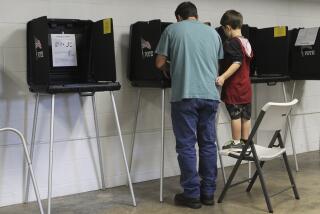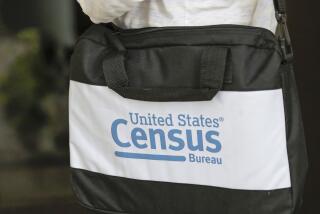House Balks on Census Count by âSampleâ Method
WASHINGTON â In a move demographers say would ensure an inaccurate census and could cost California up to $1 billion in lost revenue, the House on Tuesday refused to allow the Census Bureau to use statistical estimations as part of its count of the nationâs population in 2000.
The GOP-backed provision--which is not yet the final word on the issue--would bar census officials from spending any money on so-called sampling until the Supreme Court reviews the techniqueâs constitutionality. The officials have hoped that the method--designed to include hard-to-count residents by statistical projection--would compensate for a significant undercount that they said made 1990âs census the most inaccurate in the nationâs contemporary history.
The delay for judicial review would effectively end the bureauâs plans to employ sampling in 2000, because demographers would have no time to test the method in a dress rehearsal planned in two cities--including Sacramento--for April. Census officials say it would be irresponsible to attempt the technique without a trial run.
âThis is terrible news for California,â Rep. Henry Waxman (D-Los Angeles) said of Tuesdayâs House vote.
Census officials say money for sampling would have to be made available before Congress recesses for the year, probably in mid-November, if the bureau is to have time to prepare for the trial run.
Sampling supporters are pinning their hopes on two fronts. The Senate has already approved funding for sampling, which means the two chambers must thrash out their disagreement in a conference committee, which is likely to meet within a few days.
Also, President Clinton has promised to veto the $31.8-billion Commerce Department spending bill that would provide money for sampling if the measure would effectively bar use of the method. He made good on a similar threat earlier this year when Republicans tried to bar sampling as part of disaster relief legislation.
Administration advisors have recommended a veto of the House bill, and observers see few reasons why Clinton would not follow their advice.
Congressional sources say Republican House leaders have made blocking sampling a top priority. But the sources note that doing so in the face of a Clinton veto could cost them politically because that would hold up the Commerce spending bill--which also funds the State and Justice departments. Such a standoff would evoke memories of the unpopular government shutdowns of 1995-96.
The House vote against sampling was 227 to 198, short of the two-thirds majority needed to overturn a presidential veto.
âWe are increasingly having a problem doing this count accurately. The error rate skyrocketed in 1990,â said Rep. Alan Mollohan (D-W.Va.), who sponsored the bid to allow sampling. â . . . If we donât do something, it is estimated that in 2000 the undercount will climb. Thatâs a lot of men, women and children who will be left out of our nationâs family.â
But GOP opponents called sampling a ârisky statistical schemeâ that might ultimately be found illegal.
âTo blindly move forward with a $5-billion census that could well be thrown out by the Supreme Court would be very foolish,â said Rep. Dennis Hastert (R-Ill.), citing the Constitutionâs requirement for âactual enumerationâ every 10 years. âTo enumerate means to count one by one. It does not mean we should use sampling as a shortcut just because counting might be hard.â
But sampling proponents charged that the GOP was more concerned with its partyâs strength than the integrity of the Constitution. Congressional districts are drawn based on population, and demographers believe that 60% of the undercounted are minorities and the urban poor, who tend to be Democrats. Congressional sources said House Speaker Newt Gingrich, who endorsed sampling after 1990, told his ranks at a private meeting recently that sampling is âa dagger aimed at the heartâ of the GOP House majority.
The vote on sampling was not strictly partisan, however. The effort to fund the method garnered some Republican support, while a handful of Democrats from states that stand to lose congressional seats in the new census defected and voted against sampling.
If court review of sampling is required, the Census Bureau will be forced to rely on the traditional head count that its officials say missed about 5 million people in 1990, more than a million of them in California.
Few states were more dramatically undercounted. Census takers put Californiaâs population at 29.7 million, a figure they later acknowledged was about 1 million too low. Experts say the error was primarily because of the stateâs high population of immigrants and urban poor, who tend to be hard to count.
If the 2000 census yields a similar undercount, as demographers say it will without sampling, California stands to lose as much as $1 billion in federal money that would be portioned out on the basis of population in the decade after the count, according to federal budget experts.
Using the sampling method, enumerators would make every effort to count at least 90% of the nationâs population, but then would estimate the remaining 10% with statistical projections that rely on data gathered from those who were actually counted.
The issue is politically sticky for Republicans from California torn between eroding their voting bases and raking in revenue for the state. Gov. Pete Wilson has endorsed the method only when asked, and none of the stateâs GOP members of Congress supported sampling Tuesday.
Census officials have said a count without sampling would cost an additional $1 billion to dispatch scores of enumerators to comb neighborhoods for anyone missed. Even with that, the officials say, it is no longer realistic to tally each person directly. The large, shifting population of newcomers and a growing lack of public cooperation with census takers has made the official count increasingly imprecise, they say.
More to Read
Get the L.A. Times Politics newsletter
Deeply reported insights into legislation, politics and policy from Sacramento, Washington and beyond. In your inbox three times per week.
You may occasionally receive promotional content from the Los Angeles Times.










